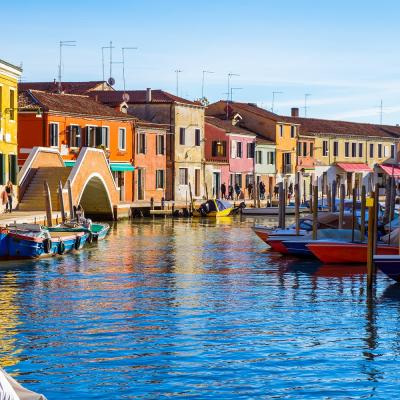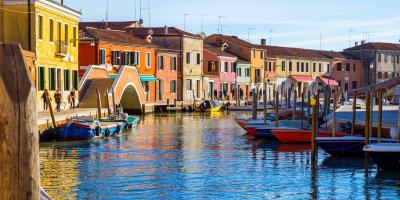Veneto
The Veneto region is a region located in the eastern part of northern Italy with the capital city of Venice. It is the most visited region in Italy and the sixth in Europe and first in Italy (Eurostat data 2018).
It is bordered on the east by the Adriatic Sea, on the north by Austria, on the northeast by Friuli Venezia Giulia, on the west by Lombardy, on the northwest by Trentino-Alto Adige, and on the south by Emilia-Romagna.
Veneto has diverse landscapes in its interior: ranging from the coasts washed by the Adriatic Sea to the plains towards Friuli, all uniform, to the hilly areas of the mountains (Euganean Hills and Berici Hills), and the Dolomites (highest peak the Marmolada 3343 meters). The Po, Tagliamento and Livenza rivers furrow the territory dictating its morphological boundaries. Important is the catchment area of the Piave.
There are natural parks for the protection of fauna and flora, including the national park of the Belluno Dolomites, the Ampezzo Dolomites, the Euganean Hills, Lessinia, the Sile River, and the Po Delta.
Climate: very varied. It ranges from the cold of the Dolomites to the Mediterranean of the Adriatic coast. The microclimate of Lake Garda makes the area unique: hot summers and mild winters. In most of the area the climate is sub-continental, and overall temperate, thanks to the protection of the mountains and the sea breeze.
Tourism
Tourism is fundamental to Veneto: it is the most visited region in Italy. The opportunities are innumerable and can be divided into macro-categories, just to give the tourist an overview: one can admire the cities of art (Venice, Verona, Mantua), appreciate the sea, the mountains, the Spas, and the lakes. Thanks to its landscape, historical, artistic, and architectural heritage, Veneto is a popular destination.
Of note are the eight UNESCO sites in the Veneto: the Botanical Garden of Padua, Verona, Vicenza and the villas of Andrea Palladio, the Dolomites, Venice and its lagoon, and the prehistoric pile-dwelling sites (Two in the Province of Verona: one in Peschiera del Garda, between Belvedere and Frassino, and one in Tombola, near Cerea. One in the Province of Padua located in the Laghetto della Costa at Arquà Petrarca near the Euganean Hills), the Venetian Defense Works between the 16th and 17th centuries, and Hills of Conegliano and Valdobbiadene.
In Veneto, the cities of art practically coincide with the provincial capitals, which have been important since antiquity as central nodes of the trade of the Roman routes and of the noble families that succeeded one another over time. At present, one still breathes the polycentric reality of Venetian cities.
Among the towns not to be missed is certainly Venice, the historic capital of this region. A city suspended over the water, the child of sublime minds, since ancient times, capable of making a dream come true: that of living practically in symbiosis with the sea, exploiting its characteristics, almost "taming" the perpetual motion of the water. Its monuments include St. Mark's bell tower, St. Mark's basilica, the Doge's Palace, the three churches designed by Andrea Palladio (San Giorgio, Zitelle, Redentore), the Gallerie dell'Accademia (which houses an artistic itinerary dedicated to Venetian painters), the churches of Santa Maria Gloriosa dei Frari and Santi Giovanni e Paolo, and the Rialto Bridge. It is home to the Art Biennale, international social events, the Film Festival...
Another important destination is Verona, an important route because of its strategic location. Don't miss the Arena of Verona, the Castelvecchio, the Basilica of San Zeno, the Duomo, the church of Santa Anastasia, the Castelvecchio bridge, the Pietra bridge, the balcony attributed to Romeo and Juliet by tradition, and the various squares in the historic center where you can enjoy spritz, the classic Veneto aperitif. A city to experience. Padua is another important center in the Veneto region. Famous for the university, the Basilica of St. Anthony of Padua, the huge Prato della Valle square, the Palazzo della Ragione, Palazzo del Bo, the Scrovegni Chapel, the Cathedral of Padua, the church of Santa Sofia, the civic museums, and the Eremitani church. In Vicenza there is all the essence of the great architect Andrea Palladio, who signed many parts of the Veneto region with his villas and ingenious works for the time. A walk down Corso Palladio is a must to admire the palaces, the Basilica Palladiana, the Teatro Olimpico, the Palazzo Chiericati, and the Sanctuary of the Madonna of Monte Berico, which dominates the city from the hill of Monte Berico.
Not to forget Treviso and Belluno for an overview of the Veneto.


